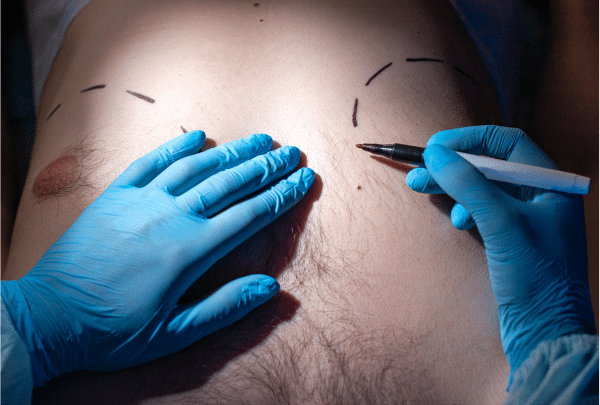How to Assess Gynecomastia Surgery Before and After Photos
Gynecomastia surgery before and after photos show men with enlarged breasts who are transformed into men with a more masculine appearance. Often, the men in the “after” photos not only have flatter, stronger-looking pecks, but they’re fitter overall. Sometimes, they’ve got a nice tan going, with more discernible muscle contours and a slimmer, fitter overall look.
How does this miraculously occur?
Naturally, the gynecomastia surgery itself gets rid of the excess fat, skin, and/or glandular tissue in the patient’s breasts. But often, gynecomastia surgery patients are so happy with their results, that it can give them the confidence boost they need to work out more in the gym, eat better, and take better care of their bodies overall. In this case, benefits beget benefits, and we love to see these transformational results.
But if you are still in the early stages of thinking about gynecomastia surgery and finding a qualified surgeon, not to worry — your day will come. For now, we invite you to learn more about how to look at gynecomastia procedure before and after photos as you peruse them in search of a surgeon.
What You Need to Know About Gynecomastia Before and After Surgery Pictures
Male gynecomastia surgery before and after photos are easy enough to find on the Internet. But unfortunately, not all photo sets are created equal.
It’s also important to be on the lookout for bad gynecomastia surgery before and after photos. And it’s equally important to scrutinize those you find with decent results. Here are some tips to keep in mind:
1. Check for even lighting.
Even lighting allows you to assess a patient’s results accurately. Deep shadows or uneven lighting patterns that don’t match in the before and after sets can make it difficult to see if the results are actually effective and attractive.
2. Check for similar body positions and camera angles.
Likewise, patients should be positioned the same way in the before and after sets. You’ll also want to see multiple angles. For gynecomastia surgery patients, it can be helpful to see a side or angled view as well as a dead-on view from the front.
3. It’s good to see a variety of patients.
You’ll know if a surgeon is truly gifted with gynecomastia surgery if they have multiple patients with different challenges and great results. This tells you that your surgeon can handle varied gynecomastia-related issues and achieve positive results with all of them.
4. Read the descriptions.
Photo descriptions are useful because they’ll tell you if a patient had fat-only reduction (liposuction) or if they had glandular tissue and/or excess skin removed as well.
5. Look for patients who look similar to you.
When you can find a “before” photo set that matches your current look and challenges, it is especially helpful. In particular, if you find that patient’s results to be satisfactory, you’ll know this surgeon can likely handle your surgery well.
6. Look for attractive, masculine results with little visible scarring.
And lastly, you, of course, want to like the results you see. Patients should show a visible reduction in breast tissue and fat, minimal scarring, and an attractive and masculine appearance in their “after” photos.
What You Need to Know About Gynecomastia Surgery
Many men want to know how to get rid of gynecomastia. Here’s what you need to know about the steps leading to the procedure, the procedure itself, and recovery.
Gynecomastia Consultation
Both before and after gynecomastia surgery, there are certain steps you must take. First, you’ll book a gynecomastia removal consultation appointment.
A gynecomastia pinch test is usually used to see the extent of your gynecomastia. Your surgeon will learn about your concerns and discuss your options for surgery.
Gynecomastia Surgery Preparation
Before surgery, it’s important to lead a healthy lifestyle, eating a healthy diet and exercising. You may need to change or stop certain medications, undergo additional screening tests, and/or stop smoking.
Gynecomastia Procedure Steps
Gynecomastia is performed as an outpatient procedure most of the time. First, anesthesia is administered, then incisions are made. Next, liposuction, skin excision, and/or glandular tissue removal takes place. Finally, the incisions are closed, and you are taken to a recovery room.
Gynecomastia Surgery Recovery
Every patient’s gynecomastia surgery recovery time will be different. Most patients have fully recovered and are back to their normal daily activities within six weeks. You must refrain from exercise for at least two weeks, and you’ll need to wear your compression garment for around three weeks.
FAQ: Gynecomastia Surgery
How much does gynecomastia surgery cost?
When it comes do gynecomastia surgery cost, numbers differ, depending on whether the patient requires liposuction only, skin excision, glandular tissue removal, or a combination of these. The decision between general and local anesthesia can also make a difference in the cost, as can where geographically you decide to undergo surgery. Surgeons who are highly skilled and experienced with gynecomastia surgery may also charge more because they are more in demand.
Will I have scars after gynecomastia surgery?
Whether you have a noticeable gynecomastia scar depends on what type of surgery you require. Correction of excess fat only will result in only small liposuction incisions. A larger incision will be required if skin excision and/or glandular tissue removal is needed. These incisions are usually made within each breast crease on the chest.
Request a Gynecomastia Surgery Consultation Today

You can get rid of excess glandular tissue, fat, and skin in your breasts and improve self esteem with gynecomastia surgery performed by double board certified plastic surgeon Dr. David Sieber. Call today to schedule your consultation appointment.
References
https://www.plasticsurgery.org/news/blog/four-tips-to-prepare-for-male-breast-reduction-surgery




